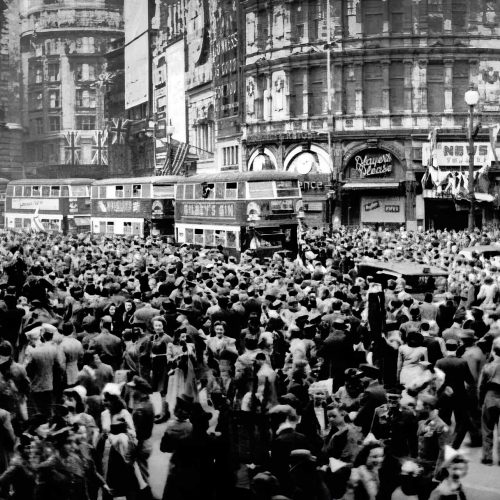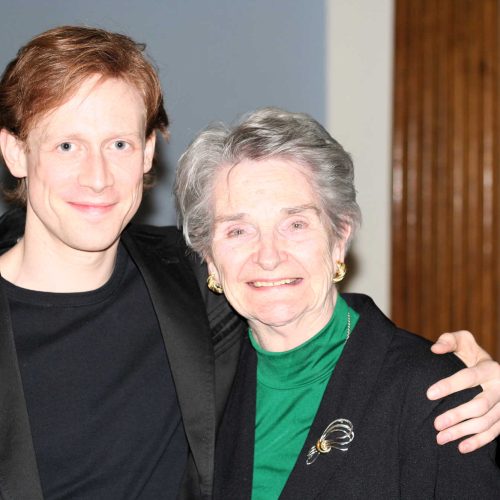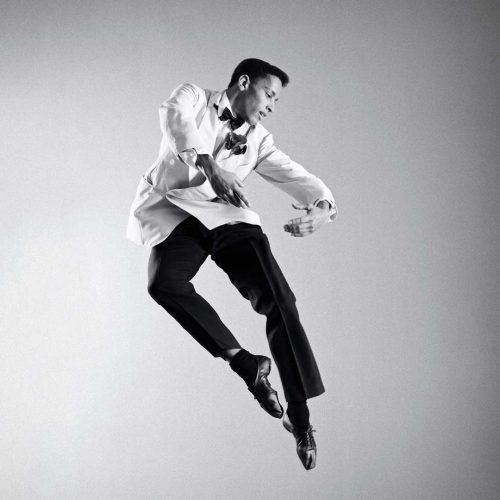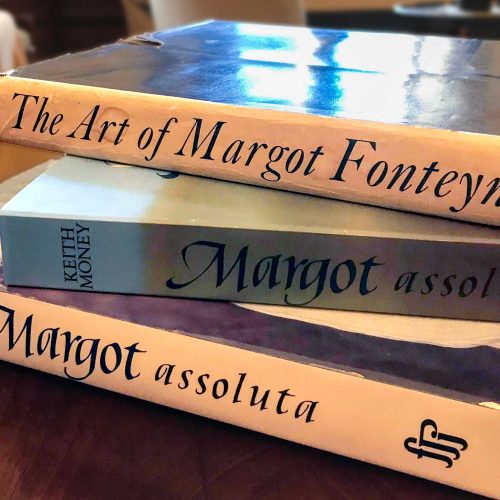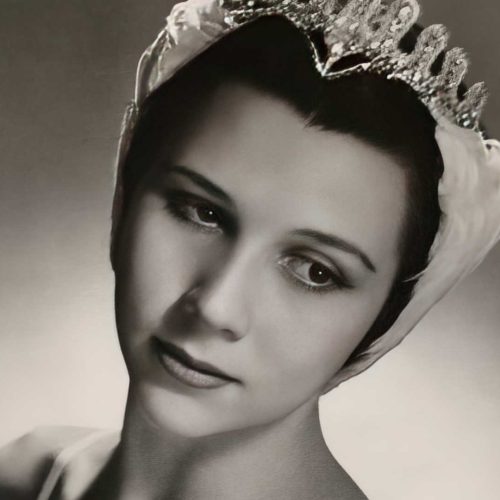Joan Seaman
Joan Seaman gives us a wonderful bird’s eye view of VE Day, which she spent seeing Sadler’s Wells Ballet stars Margot Fonteyn and Robert Helpmann dance Coppélia, and her interview is full of the amazing good humoured selflessness demostrated by so many young people in World War II. Joan had volunteered to serve in the WAAF at 19 and was stationed at Stanmore. It was during this time, on trips into London, that she discovered what would be a life-long enthusiam for ballet. She later went on to become deeply involved in the Ballet Association, an organisation founded to support the Royal Ballet and associated companies. In this episode she talks to Gerald Dowler about her first encounters with ballet whilst volunteering with the WAAF.
First published: May 8, 2025
Biography
Joan Margaret Seaman (née Allan) was born in 1923. She showed an early talent for the piano and studied at the London School of Music, as well as Harrow College of Art, where she took part in a wide variety of performing arts. In 1942 she enlisted in the Women’s Auxiliary Air Force (WAAF). She was posted to Fighter Command HQ at Bentley Priory in Middlesex, which enabled her to travel to London when off-duty to watch ballet, the start of a life-long enthusiasm. After the war, she travelled to Europe where she entertained the troops playing the piano in RAF jazz and dance bands.
In 1950 she married Bill Seaman, an RAF officer, and moved to West Dulwich, where they had two sons and she lived for the rest of her life. Bill died in 1975, by which time Joan had begun to teach at an Infant School in Lambeth. After retiring from teaching in the late 1980s, she took a history degree from the Open University.
Joan’s war-time enthusiasm for ballet, particularly for The Royal Ballet, continued for the rest of her life, the ballet world being for her a second family. After her retirement, she joined The Royal Ballet on tours to the United States of America, Mexico and Europe. She attended performances at Covent Garden until well into her nineties, when immobility finally prevented this. Joan Seaman was an intelligent and cultured woman, never short of strong opinions on ballet and other topics, opinions she was always ready to share.
Transcript
in conversation with Gerald Dowler
Joan Seaman: I was then coming up 19, and the thing was that you volunteered, because at 19 you were going to be called up, and that meant you could have been in anything, so the answer was to volunteer before you were called up, and you could have some choice. So I went to Edgware, I think it was, the place I had to go to, I volunteered for the Air Force, and they said, ‘What would you like to do? I said, ‘Well, radar,’ and they said, ‘Are your Maths good?’ I said, ‘No,’ and they said, ‘Well I think Clerk’s (Special Duties) would be better.’ I had no idea what it was, so I said yes. I still had no idea quite what it was.
Gerald Dowler: Did you enjoy the time? I mean…
Joan Seaman: Not then.
Gerald Dowler: Not then.
Joan Seaman: Oh no. No, no, not at all.
Gerald Dowler: Because you were away from home?
Joan Seaman: Oh no, it wasn’t being away from home, I hated the boredom of it. I hated having to march, and I hated having to call people ‘Ma’am’, and you had no freedom. You had no individuality. And then much to my great surprise, there was just three of us chosen to go to Stanmore.
Gerald Dowler:Right.
Joan Seaman: I rang my mother and said, ‘I am going to Stanmore, it’s only four miles away from home!’ I was crying on the phone, my mother was crying on the phone as well. So anyway, I went to Headquarters Fighter Command, in the operations room, 50 feet under the ground,
But then, we get to the ballet. My friend and I used to go up to town, come off duty at eight o’clock, go up to London straight away on the Tube, and get forces tickets at a kiosk in Leicester Square. And one day I said, ‘Look, I used to play the piano for the ballet.’ Yes, that’s something I did too, while I was still at school. That was on Saturday mornings, three classes on a Saturday morning. Half a crown! But, anyway, I said, ‘But I have never actually seen the ballet, shall we try and see one?’ ‘Yes,’ said my friend, ‘Yes, yes, alright, we’ll see it.’ So we got a ticket for that night, to go to the New Theatre. We had no idea what we were going to see, anything about it at all, and I got [Margot] Fonteyn and [Robert] Helpmann in Swan Lake, and that was it. And then of course more, and more, and more I started to go, and that sort of thing.
Gerald Dowler: So they [the Sadler’s Wells Ballet] were performing at the New Theatre.
Joan Seaman: Yes.
Gerald Dowler: And the type of ballets that you saw?
Joan Seaman: Oh, yes. Miracle in the Gorbals, Hamlet, Rake’s Progress. A typical programme was the second act of Swan Lake, with Fonteyn and Helpmann, and then there could be Dante Sonata, and then, oh, quite often there was a classical pas de deux, with still again Fonteyn and Helpmann, and then it could finish with Façade, or Rake’s Progress. I think [Les] Sylphides was the only ballet that was really just straight dancing.
Gerald Dowler: Right, right.
Joan Seaman:Everything else was drama.
Gerald Dowler: So the way you got into it was really through the dramatic side.
Joan Seaman: It was the fact that there was a movement, and theatricality, on top of my love of music, which was deep seated since [I was] ten years old.
Gerald Dowler: Right, and how was the music played?
Joan Seaman: Oh, beautiful, because they do say in some of the books that it was two pianos. I never saw it at the New Theatre with two pianos, but it was conducted all the time by Constant Lambert.
Gerald Dowler: And were there any dancers at the beginning, in the first few years of watching them, that really struck with you? You thought, ‘Yes,’ you know-,
Joan Seaman:Well, of course Fonteyn.
Gerald Dowler: Yes.
Joan Seaman:And Helpmann of course. Helpmann in Dr Coppelius, there’s only one person I have ever seen, and I have told him this, that gave me the same feeling, and that was William Tuckett.
Gerald Dowler: Right.
Joan Seaman:Yes. Nobody else has ever had [incomp] like that, and I have heard it said, now this is just something I have heard it said, that [Ninette] de Valois used to say, before Helpmann went on the stage, ‘Go on Bobby, go and make us laugh.’ You know, which of course he did. I mean Prospect Before Us, they have tried to revive it, but nobody could make them laugh as he did. No.
And Moira Shearer, of course. She was the most beautiful woman I have ever seen. Never struck me particularly for her dancing, but then I really didn’t have much criteria. It’s always, and even now, even now it’s not the wonderful (dancing) – it’s if they interpret the music, and that’s me personally, that’s my own personal feeling.
Gerald Dowler: So musicality is the…
Joan Seaman: Yes. You know, my favourite dancers have always been the dancers that interpret the music.
Gerald Dowler: So that continued, these type of performances continued during the War?
Joan Seaman: Yes.
Gerald Dowler: So was there a big change then, when the War ended?
Joan Seaman:Well yes, I think I ought to say about VE [Victory in Europe] Night.
Gerald Dowler: Of course, yes.
Joan Seaman: Because that was something. I was, of course, still working at Stanmore, Fighter Command, but they had closed the operations room, of course, there was nothing to do, you know. But I happened to have a ticket for the New-, for the Sadler’s Wells Ballet at the New Theatre, which I had booked, oh, ages before, before any idea of the end of War or anything, but I happened to have that night. So I thought, ‘I might as well go.’ You know, there was nothing particular more, you know. So I went by Tube, and I found they had altered the programme.
Gerald Dowler: Right.
Joan Seaman: It was not the mixed programme, they were going to do Coppélia, with Fonteyn and Helpmann, and everybody went mad, on stage, and off. When the curtain went up, there was Helpmann sticking the flags of all nations into the doll Coppélia’s balcony. Fonteyn, when she came on for her solo, in Coppélia, somebody let off a firework outside, and went around to the whole of the audience going, ‘Da, da, da, da, da, da.’ It was an absolute riot, it really was. Again, I dined out on that, because people in the company have said, ‘You were actually there on that night?’
Gerald Dowler: Yes.
Joan Seaman: Yes! Just by sheer chance.
Gerald Dowler: Yes.
Joan Seaman: Anyway, I came out of there, and I was by myself, so everybody was laughing and singing, and that sort of thing. I thought, ‘No,’ there was going to be a dance at the camp, and they had the Sky Rockets dance band. Well I had been the relief pianist at times, you see, so I knew the boys, I knew the men, and that sort of thing, and I thought, ‘Oh, I will go up.’ So I got the Tube, up to Stanmore station, and there were always coaches going up and down, because Bentley Priory was on top of a hill, and going up and down all the time. So I got on that. And of course I knew that place, a bit like me knowing Covent Garden, you know, I knew that place. I went into the stage door, and into the green room, and there was Pat Dodds, the pianist, he had obviously had a little too much to drink to say it, and he looked at me with bleary eyes, and he said, ‘Oh Joan, thank God you’re here! Go and take over!’ So I went up on that platform. I mean, most of the other band, they were playing absolutely by-, well, by instinct, more than anything else. It was then midnight, near enough, so I played the piano until the whole thing stopped at about two o’clock, I then got on my cycle, and I cycled home, and that was my VE Day, and I doubt that anybody had a VE Day like mine! I mean, a lot of people have said, ‘Oh, we were laughing, we were talking, we had dancing in Trafalgar Square.’ No, not me! I was watching the ballet, then afterwards I do what I have done all my life, I was playing the piano!
The transcript of this podcast may have been lightly edited for ease of reading.

